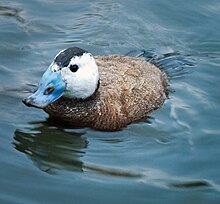White-headed duck
| White-headed duck | |
|---|---|

| |
| Male in summer | |

| |
| Female | |
| Scientific classification | |
| Domain: | Eukaryota |
| Kingdom: | Animalia |
| Phylum: | Chordata |
| Class: | Aves |
| Order: | Anseriformes |
| Family: | Anatidae |
| Genus: | Oxyura |
| Species: | O. leucocephala
|
| Binomial name | |
| Oxyura leucocephala (Scopoli, 1769)
| |

| |
| Oxyura leucocephala range
Breeding Resident Non-breeding Passage Vagrant (seasonality uncertain) Probably extinct
| |
The white-headed duck (Oxyura leucocephala) is a small stiff-tailed duck some 45 cm (18 in) long. The male has a white head with black crown, a blue bill, and reddish-grey plumage. The female has a dark bill and rather duller colouring. Its breeding habitat is lakes with open water and dense vegetation at the margin. It dives under water and feeds on aquatic vegetation as well as some animal matter. It is more likely to swim away from a perceived threat than to fly. This duck is known from Spain, North Africa, Western Asia and Central Asia. Populations are declining, mostly due to loss of habitat and pollution, and the International Union for Conservation of Nature has rated the bird's status as "endangered".
Description
Adult males have a grey and reddish body, a blue bill and a largely white head with a black cap and neck. Adult females have a grey-brown body with a white face and a darker bill, cap, and cheek stripe. Length is 43–48 cm (17–19 in) and weight is 580–750 g (1.28–1.65 lb).

Distribution

This duck breeds in Spain and North Africa, with a larger population in western and central Asia. Their breeding habitat is large tracts of open water, such as lakes and ponds including artificial water bodies, with dense stands of aquatic plants to provide shelter and nesting sites.[2] Individuals are fairly frequently reported well north of their breeding range, but as with many wildfowl, the status of these extralimital records is clouded by the possibility of escapes from collections.
Ecology
These birds dive and swim under water. They are omnivorous, with vegetable matter predominating. They are reluctant to fly, preferring to swim for cover.
This duck is considered endangered due to a large reduction in populations in the last 10 years. Most of this decline is due to habitat loss and hunting, but interbreeding of the Spanish population with the introduced ruddy duck (Oxyura jamaicensis) is a more recent threat. This has led to the attempted eradication of the American species from western Europe.
The white-headed duck is one of the species to which the Agreement on the Conservation of African-Eurasian Migratory Waterbirds (AEWA) applies, and the International Union for Conservation of Nature has rated the bird's conservation status as being "endangered".[1]
References
- ^ a b BirdLife International (2012). "Oxyura leucocephala". IUCN Red List of Threatened Species. 2012. Retrieved 26 November 2013.
{{cite journal}}: Invalid|ref=harv(help) - ^ White-headed Duck (Oxyura leucocephala) in Armenia. 2017. In online publication: "The State of Breeding Birds of Armenia". TSE NGO, Armenian Bird Census Council. Retrieved on 10 October 2017.
Further reading
- Gantlett, Steve (1993) The status and separation of White-headed Duck and Ruddy Duck Birding World 6(7): 273-281

